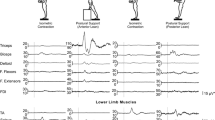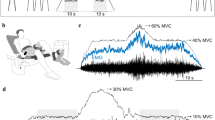Summary
Amplitude modulation of the quadriceps H reflex was investigated during the early part of the stance phase of gait in normal human subjects. Stability of the M wave was used to ensure constancy of the effective stimulus strength. In all subjects there was a progressive decrease in the reflex amplitude throughout the early knee flexion (yield of the knee), whereas the quadriceps EMG activity remained constant or even increased. At an equal stimulus strength and EMG level, the reflex was often larger at the onset of the stance phase of gait than during voluntary contraction, whereas it was always smaller during the knee extension following the yield of the knee. It is argued that changes in presynaptic inhibition of quadriceps Ia terminals could account for this amplitude modulation of the monosynaptic reflex during gait. The possible role of changes in the gain of the quadriceps stretch reflex during bipedal gait is discussed.
Similar content being viewed by others
References
Bayev KV (1980) Polarization of primary afferent terminals in the lumbar spinal cord during fictitious locomotion. Neurophysiology 12:305–311
Burke D, Gandevia SC, McKeon B (1984) Monosynaptic and oligosynaptic contributions to human ankle jerk and Hreflex. J Neurophysiol 52:435–448
Burke RE (1981) Motor units: anatomy, physiology, and functional organization. In: Brooks VB (ed) Handbook of physiology, Sect I. The nervous system. Amer Physiol Soc, Bethesda MD, pp 345–422
Capaday C, Stein RB (1986) Amplitude modulation of the soleus H-reflex in the human during walking and standing. J Neurosci 6:1308–1313
Capaday C, Stein RB (1987) A method for the simulation of the reflex output of a motoneurone pool. J Neurosci Methods 21:91–104
Crenna P, Frigo C (1987) Excitability of the soleus H-reflex arc during walking and stepping in man. Exp Brain Res 66:49–60
Fournier E, Meunier S, Pierrot-Deseilligny E, Shindo M (1986) Evidence for interneuronally mediated Ia excitatory effects to human quadriceps motoneurones. J Physiol (Lond) 377:143–169
Gottlieb GL, Agarwal GC, Stark L (1970) Interactions between voluntary and postural mechanisms of the human motor system. J Neurophysiol 33:365–381
Katz R, Meunier S, Pierrot-Deseilligny E (1988) Changes in presynaptic inhibition of Ia fibres in man while standing. Brain 111:417–437
Meunier S, Pierrot-Deseilligny E (1988) Time course of changes in presynaptic inhibition of Ia fibres during voluntary contraction in man. J Physiol (Lond) 406:40 P
Morin C, Katz R, Mazières L, Pierrot-Deseilligny E (1982) Comparison of soleus H-reflex facilitation at the onset of soleus contractions produced voluntarily and during the stance phase of human gait. Neurosci Lett 33:47–53
Pierrot-Deseilligny E, Bussel B (1973) A comparison of H-reflex at the onset of a voluntary movement or a polysynaptic reflex. Brain Res 60:482–484
Author information
Authors and Affiliations
Rights and permissions
About this article
Cite this article
Dietz, V., Faist, M. & Pierrot-Deseilligny, E. Amplitude modulation of the quadriceps H-reflex in the human during the early stance phase of gait. Exp Brain Res 79, 221–224 (1990). https://doi.org/10.1007/BF00228893
Received:
Accepted:
Issue Date:
DOI: https://doi.org/10.1007/BF00228893




